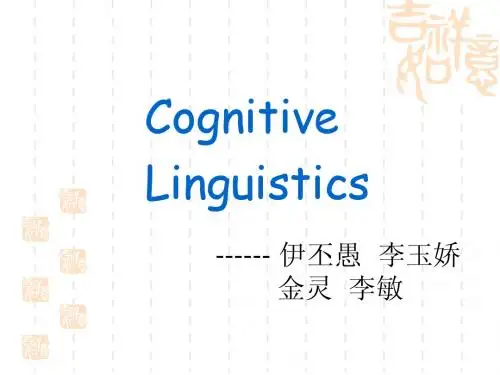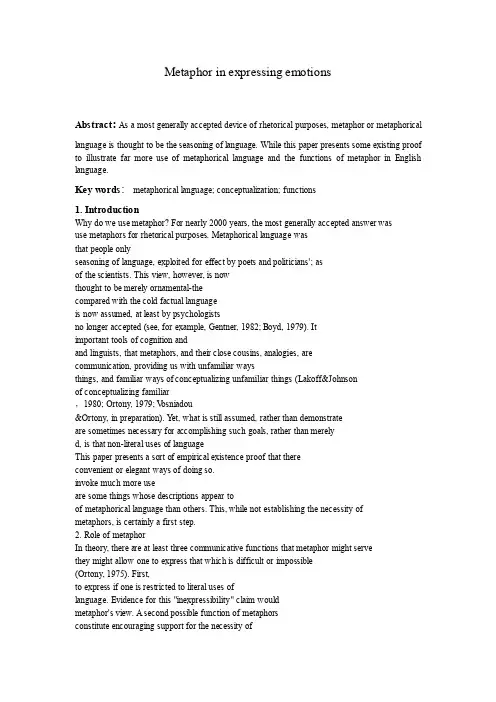认知语言学1.Introduction
- 格式:pptx
- 大小:409.60 KB
- 文档页数:32

认知语言学
一、引言
在语言学领域中,认知语言学是一门研究人类语言认知过程的分支学科。
通过研究人类认知系统如何处理和理解语言,认知语言学试图探寻语言习得、语言使用以及语言理解背后的认知机制。
本文将深入探讨认知语言学的基本概念、研究方法和相关实践应用。
二、认知语言学的基本概念
认知语言学是一种结合了心理学、语言学和计算机科学的跨学科研究领域。
它关注如何人类的认知系统利用符号系统来组织和理解语言,探究语言如何影响人类思维和表达方式。
认知语言学强调个体在语言过程中的认知能力和处理方式,从而揭示语言和思维之间的密切联系。
三、认知语言学的研究方法
认知语言学采用多种研究方法来探究语言认知过程。
其中,实验研究是认知语言学的主要方法之一,通过实验设计和数据分析,揭示出不同语言任务对认知系统的影响。
另外,神经科学方法、计算模型和语料库分析等也被广泛运用于认知语言学研究中,从不同角度揭示语言处理的认知机制。
四、认知语言学的实践应用
认知语言学的研究成果对语言教学、心理治疗和人机交互等领域具有广泛的应用前景。
通过理解语言认知机制,我们可以改进教学方法,提高语言学习效率;或者通过干预认知过程,帮助患有语言障碍的个体进行康复治疗;同时,认知语言学还为智能机器人和人工智能技术的发展提供了重要的理论支持。
五、结论
认知语言学作为语言学研究中的重要分支,不仅为理解人类语言认知过程提供了新的视角,也为应用性领域的发展带来了新的机遇。
通过深入研究语言和认知之间的关系,认知语言学将继续推动语言学领域的发展,并为人类认知研究带来新的启示。

论认知语言学的概述现代语言学的研究表明,认知与语言有着千丝万缕的联系,但语言的认知研究作为一门独立的学科却是20世纪70年代末兴起的,80年代中期以后其研究范围扩展到了语言学中的许多领域,包括句法学、语义学、音系学、篇章分析等。
1989年在德国召开的第一次国际认知语言学会议以及l990年创刊的《认知语言学》杂志,标志着认知语言学的学科地位得以确立。
此后,认知语言学的发展非常迅猛,越来越多的学者开始从认知的角度来研究语言。
一、认知语言学的基本观点(一)认知语言学是认知科学发展的产物认知语言学是认知科学的一部分,而认知科学是一门综合科学,由心理学、语言学、人类学、哲学、计算机科学等多学科组成的交叉学科,从多角度来探索思维的奥秘。
人类思维的结晶是语言,语言是人类表达观念和思想的方式之一,是认知系统的一部分,是人类体验、文化、社会、风俗、环境等因素相互作用的结果。
认知语言学一方面运用认知科学的理论和方法来探讨语言现象,另一方面又通过语言现象来揭示人的认知能力,把语言认知作为人的整体认知过程的一部分来把握。
(二)认知语言学研究中的范畴理论“范畴化”(categorization)可以说是人类最重要最基本的一种认知活动,是指人类在演化的过程中对外界事物进行分类或归类,使无序的世界变成有序的、分等级的范畴体系。
这个过程(即范畴化的过程)就是认知,或者说是认知的第一个环节。
范畴化使人类从千差万别万事万物中看到相似性,并据此将可分辨差异的事物处理为相同的类别,从而形成概念。
在此基础上人类才能完成更复杂的认知活动,包括判断和推理。
认知的发生和发展是一个形成概念和范畴的过程,它是一种以主客互动为出发点对外界事物进行类属划分的心智过程[1]。
正如Lakoff所言:“没有范畴化的能力,我们根本不可能在外界或社会生活以及精神生活中发挥作用。
”[2]范畴化的现象很早便引起哲学家的注意,亚里士多德在《范畴篇》中系统论述了自己对范畴的观点,经典范畴观便是在此基础上形成的。

认知语言学是语言学中的一种新范式, 它包含许多不同的理论、方法及研究课题。
认知语言学肇始于20 世纪70 年代, 80 年代中期以后其研究范围扩展到了语言学中的许多领域, 如句法、意义、音系以及语篇等。
其成熟的重要标志是1989 年春在德国杜伊斯堡召开的第一次国际认知语言学会议以及1990 年出版的5认知语言学6杂志。
自诞生之日起, 认知语言学就把自己置于认知科学这一大学科中, 与哲学、心理学、人类学、计算机科学以及神经科学等结下了不解之缘, 并逐渐成为当代语言学中的一门显学。
在过去20 多年里, 认知语言学研究在几个重要领域里已卓有成效, 如范畴化、概念隐喻、转喻、多义性、拟象性以及语法化等( 参见文旭1999, 2001) 。
尽管认知语言学家内部在具体方法、感兴趣的课题、研究的切入点等方面还存在一些差别, 但他们的研究目标和基本原则有许多共同之处。
为了进一步理解并准确把握这一新的认知范式, 本文拟对认知语言学的研究目标、基本原则、研究方法作一些解释与探讨。
认知语言学的研究目标语言是人类表达观念和思想的最明确的方式之一。
从/ 表达观念和思想0的角度来研究人类语言, 这种观点就是通常所说的/ 认知观0。
这种观点认为, 语言是认知系统的一部分, 而认知系统由感知、情感、范畴化、抽象化以及推理等组成。
这些认知能力与语言相互作用并受语言的影响, 因此从某种意义上来说, 研究语言实际上就是研究人类表达或交流观念和思想的方式。
当代语言学的一个基本特点就是对认知现实主义( cognitive realism) 的承诺, 即确认语言是一种心理或认知现象。
语言学诸多门派都以探索隐藏在大脑中具有普遍性的人类语言机制作为终极目标, 换句话说, 语言分析的目的不只是描写人们的语言行为, 而是解释引起语言行为的心理结构和心理过程, 揭示语言行为背后内在的、深层的规律。
像乔姆斯基、杰肯道夫(R. Jackendoff) 、兰格克(R. Langacker) 、雷科夫(G. Lakoff) 、比尔沃思(M. Bierwisch ) 以及赫德森(R. Hudson) 这些代表不同理论方法的语言学家, 他们的研究都具有这一目的。




Metaphor in expressing emotionsAbstract: As a most generally accepted device of rhetorical purposes, metaphor or metaphoricallanguage is thought to be the seasoning of language. While this paper presents some existing proof to illustrate far more use of metaphorical language and the functions of metaphor in English language.Key words:metaphorical language; conceptualization; functions1. IntroductionWhy do we use metaphor? For nearly 2000 years, the most generally accepted answer wasuse metaphors for rhetorical purposes. Metaphorical language wasthat people onlyseasoning of language, exploited for effect by poets and politicians'; asof the scientists. This view, however, is nowthought to be merely ornamental-thecompared with the cold factual languageis now assumed, at least by psychologistsno longer accepted (see, for example, Gentner, 1982; Boyd, 1979). Itimportant tools of cognition andand linguists, that metaphors, and their close cousins, analogies, arecommunication, providing us with unfamiliar waysthings, and familiar ways of conceptualizing unfamiliar things (Lakoff&Johnsonof conceptualizing familiar,1980; Ortony, 1979; V osniadou&Ortony, in preparation). Y et, what is still assumed, rather than demonstrateare sometimes necessary for accomplishing such goals, rather than merelyd, is that non-literal uses of languageThis paper presents a sort of empirical existence proof that thereconvenient or elegant ways of doing so.invoke much more useare some things whose descriptions appear toof metaphorical language than others. This, while not establishing the necessity of metaphors, is certainly a first step.2. Role of metaphorIn theory, there are at least three communicative functions that metaphor might servethey might allow one to express that which is difficult or impossible(Ortony, 1975). First,to express if one is restricted to literal uses oflanguage. Evidence for this "inexpressibility" claim wouldmetaphor's view. A second possible function of metaphorsconstitute encouraging support for the necessity ofis that they may constitute a particularly compactmeans of communication. Although conscious experience is continuous in form, the linguistic system we use totalk about it is comprised of discretemay enable us to convey a great dealelements (lexical items). Unlike more literal forms of language, metaphorof information in apredicates to be expressed into their corresponding lexicalthe vividness of phenomenal experience. If metaphorssuccinct manner by obviating the need to isolate therepresentations. Finally, metaphors may help capturethey can paint a richer and more detailed picture of ourconvey chunks of information rather than discrete units,subjective experience than might be expressed by literalLIU Hai-yun, associate professor of Departmentof Foreign Languages, Qinghai Normal University; research fields: semantics,n Churchills, metaphor.oncenot sure what they are going to say"::"How infinite is the debt owed to metaphors by politicians who want to speak strongly but are34Metaphor in expressing emotionslanguage. This we call the "vividness".3. Analysis of the rolesLet us look at the first and last of these possible functions. In order to do so, we need to examine a discoursedomain for which a prima-facie case can be made for supposing that literal language will often be inadequate andwhich lends itself to variations in vividness. There doubtless are many such domains. The one that we selected isthat of internal states, in particular, emotional state. The literature on the linguistic expression of emotionssuggests a relatively high incidence of figurative language use (e.g, Davitaz, 1969), providing pragmatic reasonsfor believing that the context of (linguistic) emotional expression may be a profitable one within which to studymetaphor production. Emotional states seemed well-suited for our purposes because they tend to have an elusive,transient quality that is difficult to describe using literal language, although, of course, they can usually be labeledusing literal language. Thus, while it might be easy for a person to label an emotional state as, for example, "fear",it is difficult to provide a literal description of the quality of some particular experience of fear. Furthermore,because emotions vary in intensity, one might expect differential levels of vividness.4. ReasonsThere seem to be two possible ways in which people而ght try to communicate the quality of an emotionalstate. First, a speaker might use literal language to describe the events that triggered the emotional state and hopethat the hearer correctly infers how he or she felt. In such a case, the literal description would not describe thequality of the subjective state itself but would merely identify its eliciting conditions (Ortony, Clore&Collins, inpreparation). Alternatively, a speaker might use a metaphor in an attempt to describe the quality of an emotionalstate. Here, the metaphorical description does represent an attempt to characterize the quality of a subjective state.Emotion theorists frequently attribute differential significance to the subjective experience of emotion (DeRivera, 1977) or to their associated actions or action tendencies (Frijda, in press). It may be that the subjectiveexperience of an emotion can benefit more from a me帅horical description than the associated action or actiontendency. Consider the subjective experience of some specific case of anger. The quality of such a subjective statecannot be publicly observed. In contrast, the actions to which an anger experience might give rise, for example,pounding one's fist on the table, are publicly observable. Thus, one might expect people to employ moremetaphorical descriptions when trying to characterize the subjective experiential quality of emotional states thanwhen trying to characterize the overt behaviors associated with such states. It is possible that relatively mildemotional states are sufficiently unremarkable that speakers are more willing to settle for simply labeling them,whereas the vividness of intense emotional states而ght sometimes generate a more pressing need for detaileddescription.5. ExperimentTo investigate some of these issues, a simple experiment was made in order to examine the production ofmetaphors during descriptions of emotional states and events. It is predicted that people would be more likely touse metaphors and metaphorical comparisons when describing how they felt when they were experiencing anemotion than when describing what they did when they experienced it. It is also thought to be possible that moremetaphorical language would be used in descriptions of. intense as compared to mild emotional states. The two35Metaphor in expressing emotionshypotheses combined could be construed as predicting an interaction of description type (feelings vs. actions) andintensity, with the intensity factor having a greater effect on feeling descriptions than on action descriptions.Desc即tions of feeling states, which may already make use of metaphorical language, may be especially likely touse metaphors when the states are intense. On the other hand, it could be argued that although intense emotionsare more vivid than less intense ones, the associated actions do not necessarily enjoy a corresponding increase invividness. This is admittedly a tenuous argument, so the prediction of an interaction between description type andintensity is made with less confidence than the predictions of main effects for these variables. Finally, in theexperiment to test these hypotheses, the valence of the emotions was manipulated to determine whether this factorhas any systematic effect on metap卜or use.Subjects were asked to describe either how they felt when they experienced certain emotions, or what theydid when they experienced them. The emotions used included four positive ones (happiness, pride, gratitude, andrelief) and four negative ones (sadness, fear, resentment, and shame). Note that the particular hypotheses- to betested do not depend on exactly which emotions are used. In addition to providing descriptions involvingemotions of different valence, subjects were required to describe situations involving either very intenseexperiences of them or very mild ones.Metaphors were identified in the transcripts of interview sessions. Protocols were scored in terms of ideaunits (Johnson, 1970) because metaphors are generally better conceptualized as single ideas than as individualwords. Metaphors production was then measured in terms of the proportion of all distinct idea units that weremetaphorical in nature. In other words, the measure of metaphor production was the ratio of metaphor types to thetotal number of idea unit types appearing in a protocol.It was concerned that possible systematic differences in the amount of verbal output produced duringdescriptions of the different emotion-inducing events might contaminate the measure of metaphor production,such high verbal output might lead to a high production of metaphor, and low verbal output might be associatedwith little metaphor use. If so, metaphor production would be a consequence of verbal output produced and thiseffect might conceal any differential use of metaphor during descriptions of feelings and actions. By looking at theratio of metaphor types to the sum of both metaphorical and non-metaphorical ideas units, the potentialconfounding of metaphor production and amount of linguistic output was partially avoided. A second concern wasthat the subjects' tendency to repeat words and phrases during an oral account might artificially inflate themeasurement if metaphorical tokens as opposed to types were used.6. ResultsThe results showed that a significantly greater proportion of metaphors occurred in descriptions of feelingstates (17%) than in descriptions of actions (4%)3.Furthermore, the mean percentage of metaphor typessignificantly greater than in descriptions of mild ones (9%).used in description of intense emotions (12%) wasTwo factors (intensity and valence) interacted with thetype of description (feelings versus actions). First, there was a significantly greater increase in production when describing the feelings associated with intense emotions than when describing the actionsassociated with intense emotions. Second, although of less theoretical interest, while in the description of actionsz Other indices were also used, such as the absolute number of metaphor types and the proportion of the total number of ideas unitsthat were metaphorical. The choice of measure made little difference to the pattern of results, Le., the percentage of metaphor types averaged across emotions and subjects.36Metaphor in expressing emotionsthere was a tendency for more metaphors to be produced for negative than for positive emotions, this trend wasreversed for descriptions of feelings. The patterns of these interactions are shown in the table below which showsthe percentage of idea unit types that were metaphor types.┌──────────────┬────────────────┐│Intensity │V alence │├──────┬──┬────┼──────┬────┬────┤│Description │Mild│Intense │Description │Positive│Negative│├──────┼──┼────┼──────┼────┼────┤│Type │││Type │││├──────┼──┼────┼──────┼────┼────┤│Feelings │14.7│19.6 │Feelings │18.7 │15.6 │├──────┼──┼────┼──────┼────┼────┤│Actions │3.5 │4. │Actions │3.2 │4.9 │└──────┴──┴────┴──────┴────┴────┘The results also revealed that there were eight times as many frozen, or dead, metaphors as there were novelones. More interesting, however, is the fact that the ratio of novel to frozen metaphors was greater for intenseemotions (12%) than for mild ones (8%), suggesting perhaps that when people are experiencing intense feelingstates, they are more likely to generate striking and complex metaphors to explain how they feel. To the extent thatnovel metaphors are more metaphorical than frozen ones, and assuming that intense emotional states are morevivid than mild ones, this finding of more novel metaphors for intense emotions adds support to the vividnessclaim because it suggests a qualitative as well as quantitative increment in metaphor use.7. SummaryEvidence has been offered that metaphorical language may make it possible for people to convey what wouldotherwise be difficult or impossible to express. This seems to be the case with the quality of unobservable internalstates like emotions, as evidenced by our results showing the predominance of metaphorical language duringdescriptions of feeling states as opposed to actions, especially when those states are intense. For the most part, thetypes of metaphors that people used to describe their emotions were figurative forms that have becomeconventionalized in the English language. When novel metaphors were used, they seemed to be particularlyevident in descriptions of intense feeling states. Therefore, the results suggest that the inclination of psychologistsand linguists to reject the classical Aristotelian view of metaphor as merely linguistic decoration, in favor of aview that accords it an indispensable communicative function is empirically, as well as theoretically, supportable.References:Boyd, R. 1979. Metaphor and theory change: What is "metaphor" a metaphor for? In: A. Ortony.(Ed.), Metaphor and thought. NewY ork: Cambridge University Press.Davitz, J. R. 1969. The language of emotion. New Y ork, N.Y : Academic Press.De Rivera, J. 1977. A structural theory of the emotions. New Y ork: International Universities Press.Frijda, J.N. 1986. The emotions. New Y ork: Cambridge University Press.Gentner, D. 1982. Are scientific analogies metaphors? In: D Miall. (Ed.), Metaphor: Problems and perspectives, Brighton, England:Harvester Press.Johnson, R.E. 1970. Recall of prose as a function of the structural importance of the linguistic unit. Journal of V erbal Learning andV erbal Behavior, 29, 12-20.Lakoff, G&Johnson, M. 1980. Metaphors we live勿.Chicago: University of Chicago Press. Ortony, A. 1975. Why metaphors are necessary and not just nice. Educational Theory, 25, 45-53. Ortony, A. (Ed.). 1979. Metaphor and thought. New Y ork: Cambridge University Press(Edited by Vivian, Stella and Jessica)37。


《认知语言学基础知识概述》一、引言认知语言学是语言学的一个重要分支,它强调语言与认知的紧密联系,关注语言在人类认知过程中的作用和表现。
认知语言学的发展为我们理解语言的本质、结构和使用提供了新的视角和方法。
本文将对认知语言学的基础知识进行全面的阐述和分析,包括基本概念、核心理论、发展历程、重要实践以及未来趋势。
二、基本概念1. 认知语言学的定义认知语言学是一门研究语言与认知之间关系的学科,它认为语言是人类认知的一部分,语言的结构和使用反映了人类的认知方式和思维过程。
认知语言学强调语言的意义不仅仅是客观世界的反映,更是人类认知活动的产物。
2. 认知语言学的研究对象认知语言学的研究对象包括语言的各个层面,如词汇、语法、语义、语用等。
同时,认知语言学也关注语言与其他认知领域的关系,如感知、记忆、思维、情感等。
3. 认知语言学的研究方法认知语言学采用多种研究方法,包括实证研究、理论分析、跨学科研究等。
实证研究主要通过语言实验、语料库分析等方法来验证认知语言学的理论假设;理论分析则主要通过对语言现象的分析和解释来构建认知语言学的理论体系;跨学科研究则主要通过与心理学、哲学、人类学等学科的合作来拓展认知语言学的研究视野。
三、核心理论1. 范畴化理论范畴化是人类认知的基本方式之一,它是指将事物按照一定的标准进行分类的过程。
在认知语言学中,范畴化理论主要关注语言中的范畴化现象,如词汇的分类、语法结构的分类等。
范畴化理论认为,语言中的范畴化是人类认知活动的产物,它反映了人类对世界的认知方式和思维过程。
2. 隐喻理论隐喻是一种重要的语言现象,它是指用一种事物来比喻另一种事物的语言表达方式。
在认知语言学中,隐喻理论主要关注隐喻的本质、功能和认知机制。
隐喻理论认为,隐喻不仅仅是一种语言现象,更是一种认知方式和思维过程,它反映了人类对世界的认知和理解。
3. 转喻理论转喻是一种与隐喻相似的语言现象,它是指用一种事物来代替另一种事物的语言表达方式。


认知语言学主要观点-概述说明以及解释1.引言1.1 概述概述部分认知语言学是一门研究人类语言运作和理解的学科。
它的理论基础是关注语言的认知过程,即我们如何通过语言来思考、理解和表达信息。
认知语言学主要关注以下几个方面:语义(词义和句义)、句法结构(句子的组织方式)、语用(语言的使用和交流目的)、语音(声音和音调的产生和感知)以及语篇分析(文本的组织和解读)。
在过去几十年中,认知语言学得到了广泛的研究和发展。
随着认知心理学和神经科学的进步,人们对语言的认知过程有了更深入的理解。
传统的形式语言学只关注语言的形式和结构,而认知语言学则更注重人类思维和语言之间的密切联系。
它认为语言是人类思维和知识的重要载体,通过语言的学习和使用,我们能更准确地表达和理解世界。
此外,认知语言学还关注语言和文化之间的关系。
不同的语言和文化对于表达方式、词汇习惯和语义理解有着差异性。
通过比较不同语言和文化中的语言现象,我们可以更好地理解语言和文化之间的相互作用。
本文将着重介绍认知语言学的主要观点。
首先,我们将概述文章的结构和目的,然后依次讨论认知语言学的三个关键要点。
最后,我们将总结这些要点,并对认知语言学的重要性进行思考。
同时,我们也将展望未来研究的方向,以推动认知语言学的发展。
1.2 文章结构文章结构部分文章的结构是为了使读者能够清晰地理解和跟随文章的内容和逻辑思路而设置的。
一个良好的结构能够帮助读者理解文章的主题,有效地提供信息,并使整篇文章具有条理性和连贯性。
本文采用以下结构来呈现认知语言学的主要观点和要点:1. 引言:在引言部分,我们将对认知语言学进行概述,向读者介绍其背景和基本概念。
同时,我们将给出本文的结构和目的,以便读者能够清楚地了解我们的写作意图。
2. 正文:正文是文章的核心部分,我们将围绕认知语言学的主要观点展开讨论。
具体而言,我们将依次介绍三个主要要点,分别阐述它们的理论基础、研究方法和实际应用。
每个要点将以独立的小节来呈现,使读者能够逐步深入了解认知语言学的不同方面。
知识创造未来
认知语言学
认知语言学是一门研究人类语言习得、使用和理解的学科。
它探讨语言与人类思维、知觉和记忆之间的关系。
认知语
言学的核心观点是语言是人类思维的一种表达方式,人们
通过语言来组织和表达他们的思想。
这门学科涉及多个领域,包括语言习得、语言产生、语义理解、语音和语法结
构的认知过程等。
认知语言学的研究方法主要是实证研究,包括实验和观察。
通过实验研究,认知语言学家试图了解语言的认知过程,
例如我们是如何理解语言的意义和结构的。
观察研究则致
力于观察和分析人们在日常生活中使用语言的方式和策略。
认知语言学的理论框架主要有两种:一种是认知语义学,
它关注语义的认知过程和概念的表示。
另一种是认知语言
处理模型,它试图解释语言的认知加工过程,包括语言习得、语音识别、语义理解和语法分析。
认知语言学的研究具有重要的实际应用价值。
它对教育、
语言治疗、机器翻译等领域有着重要的启发和指导作用。
此外,认知语言学还与其他学科,如神经科学、计算机科
学和心理学等有着广泛的交叉研究。
1。
乔治·莱考夫认知语言学十讲第一讲:认知语言学概述本讲的主要目的是介绍认知语言学的基本概念和研究方法,以及它在语言学领域的重要性。
认知语言学是一门研究语言与思维之间关系的学科,探索语言如何反映和塑造人类认知的过程。
通过运用心理学和认知科学的理论,认知语言学试图理解语言产生、理解和运用的认知机制和规律。
第二讲:语言和认知本讲将探讨语言和认知之间的紧密联系。
我们将分析语言如何反映人类的思维机制,以及思维如何通过语言表达。
通过探索人类语言的特点和语言能力的发展过程,我们可以理解语言是如何帮助我们组织和交流思想的。
第三讲:语言的结构本讲将重点研究语言的结构,包括语音、词汇、语法和语义。
我们将探讨语音是如何组成语言的基本单位,词汇如何构成句子,以及语法和语义如何帮助我们理解和表达语言的含义。
第四讲:语言的使用本讲将关注语言的使用,包括语用学和交际行为。
我们将探讨语言是如何用于实际交流中的,并研究语言在不同语境下的使用规则和效果。
第五讲:语言的变化本讲将研究语言的变化和语言变体。
我们将探讨语言是如何随着时间和地点的变化而变化的,以及不同社会群体和文化之间的语言差异。
通过了解语言的变化,我们可以更好地理解语言的发展和演变。
第六讲:语言的习得本讲将关注语言习得的过程。
我们将研究儿童如何习得母语,以及成人如何学习第二语言。
通过探索语言习得的机制和影响因素,我们可以更好地理解语言习得的过程和困难。
第七讲:语言的障碍本讲将探讨语言障碍的原因和特点。
我们将研究语言障碍的种类和症状,以及语言障碍对个体日常交流和学习的影响。
通过了解语言障碍,我们可以更好地帮助有语言障碍的人群。
第八讲:语言与思维本讲将深入研究语言与思维之间的关系。
通过探讨语言如何塑造和影响人类思维的方式,我们可以更好地理解人类思维的本质和不同文化之间的认知差异。
第九讲:语言的演化本讲将关注语言的演化和起源。
我们将研究语言在人类进化中的角色,以及语言起源的理论。
Lecture 1认知语言学An Introduction to Cognitive LinguisticsⅠ. Introduction1.What is Cognitive Linguistics?Cognitive linguistics (CL) refers to the branch of linguistics that interprets language in terms of the concepts, sometimes universal, sometimes specific to a particular tongue, which underlie its forms. It is thus closely associated with semantics but is distinct from psycholinguistics, which draws upon empirical findings from cognitive psychology in order to explain the mental processes that underlie the acquisition, storage, production and understanding of speech and writing. Cognitive linguistics is characterized by adherence to three major hypotheses as guiding the cognitive linguistic approach to language:1) Language is not an autonomous cognitive faculty; (语言不是自主的认知能力)2) grammar is conceptualization; (语法是概念化)3) knowledge of language arises out of language use.(语言知识来源于语言的使用)Cognitive linguists deny that the mind has any module for language-acquisition that is unique and autonomous. This stands in contrast to the stance adopted in the field of generative grammar. Although cognitive linguists do not necessarily deny that part of the human linguistic ability is innate, they deny that it is separate from the rest of cognition. They thus reject a body of opinion in cognitive science which suggests that there is evidence for the modularity of language. They argue that knowledge of linguistic phenomena —i.e., phonemes, morphemes, and syntax —is essentially conceptual in nature. However, they assert that the storage and retrieval of linguistic data is not significantly different from the storage and retrieval of other knowledge, and that use of language in understanding employs similar cognitive abilities to those used in other non-linguistic tasks.Departing from the tradition of truth-conditional semantics, cognitive linguists view meaning in terms of conceptualization. Instead of viewing meaning in terms of models of the world, they view it in terms of mental spaces.Finally, cognitive linguistics argues that language is both embodied and situated in a specific environment. This can be considered a moderate offshoot of the Sapir-Whorf hypothesis, (The linguistic relativity principle , also known as the Sapir-Whorf Hypothesis, is the idea that the varying cultural concepts and categories inherent in different languages affect the cognitive classification of the experienced world in such a way that speakers of different languages think and behave differently because of it.)in that language and cognition mutually influence one another, and are both embedded in the experiences and environments of its users.2.认知语言学的诞生(The birth of cognitive linguistics)A.起始阶段(The initial stage)认知语言学兴起于20世纪70年代,20世纪80年代以后迅猛发展。
什么是认知语言学?认知语言学指的是,随着认知科学的兴起,在心理学、哲学、人类学、语言学等学科对语言和认知之间的关系进行深刻反思的背景下产生的一个新兴语言学流派。
认知语言学是一个语言学流派,其他还有生成语言学、功能语言学流派等等;它并不是一个语言学分支学科,后者包括社会语言学、文化语言学、计算语言学等等。
关于认知语言学的定义,目前还没有一个大家都认可的标准,但是有一些共同理念。
例如吴为善《认知语言学与汉语研究》一书中提到的有以下几种:Lakoff:我认为,认知语言学可以由两个共识来定义,称为概括性共识和认知共识。
Taylor:我使用“认知语言学”这一描述性的术语来表示当代语言学领域的一场广泛的运动。
它包括一系列不同的研究取向、方法和侧重点。
然而,他们通过一些共同的假设相互连接在一起。
Dirven:认知语言学可以被定义为分析语言和其他认知域,以及和其他认知机制之间关系的一种语言理论。
Evans:认知语言学是20世纪80年代初以来出现的语言学和认知科学的一个流派。
张敏《认知语言学与汉语名词短语》一书将国内外的定义总结为:认知语言学是一个以我们对世界的经验以及我们感知这个世界并将其概念化的方法、策略作为基础和依据进行语言研究的语言学学派。
那么,我们会问,为什么这个在中国及各国语言学界都有很大影响的学派,怎么连定义都没有确定呢?这就要从认知语言学的兴起说起了。
20世纪70年代之前的一段时间,乔姆斯基的生成语法理论风靡,但是很多研究者也感到了这一理论的缺陷,转而进行其他研究方法的尝试。
例如Paul Kay关于色彩词的实验,Rosch关于范畴理论的研究,Fillmore关于框架语义学的研究等。
1989年春,由R.Dirven组织的第一次国际认知语言学会议在德国杜伊斯堡举行,成立了国际认知语言学学会。
这是认知语言学成熟的标志。
目前,认知语言学在美国形成了两个学派:一是以Langacker为首的“圣地亚哥学派”;一是以Lakoff、Fillmore、Kay 为首的“伯克利学派”。